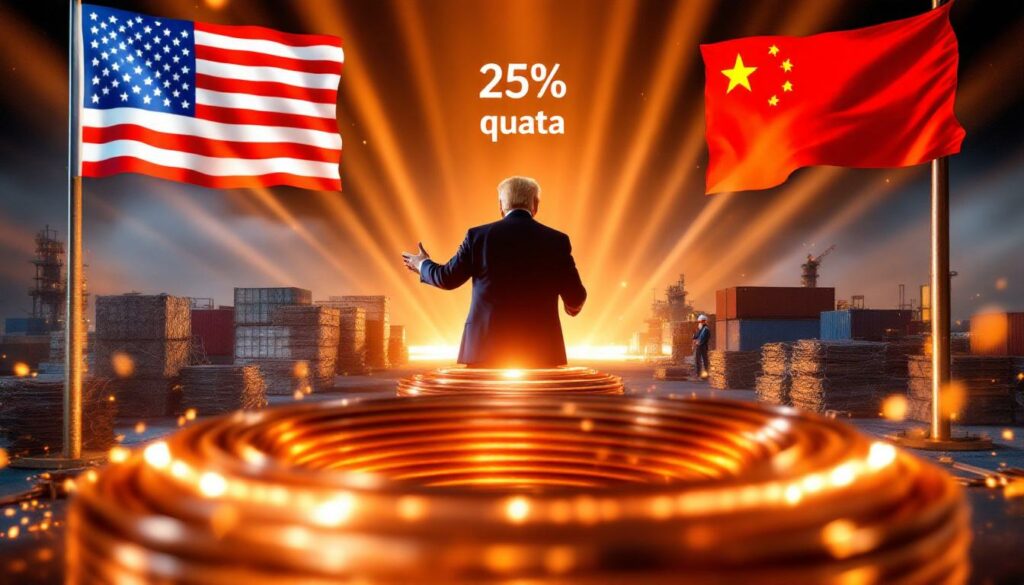Understanding Trump's Copper Scrap Quotas: Market Impact Analysis
The global metals market is monitoring significant policy shifts as the White House announces new measures focused on copper scrap retention. These measures, designed to strengthen domestic supply chains, may have far-reaching implications for the recycling industry, manufacturing sector, and international trade relationships.
What Are Trump's New Copper Scrap Export Quotas?
Key Policy Details
The White House has introduced a requirement that 25% of high-quality copper scrap produced in the United States must be sold domestically rather than exported. This policy represents a strategic shift aimed at reducing America's dependence on overseas production of refined copper and strengthening domestic manufacturing capabilities.
According to the Commerce Secretary's statement, implementation is targeted for 2027, giving industry participants time to adjust their operations and supply chains. However, a significant point of uncertainty remains: the executive order has not yet clearly defined what constitutes "high-quality" copper scrap, leaving market participants to speculate about which materials will fall under the new regulations.
Current US Copper Scrap Export Landscape
The United States currently holds the position as the world's largest exporter of copper scrap, with exports valued at approximately $4.5 billion in 2024. Historically, China has been the dominant destination for these materials, receiving roughly 50% of all US copper scrap exports.
This substantial trade flow has created a significant economic relationship between US scrap processors and Chinese refiners. However, recent trade data indicates this relationship was already changing dramatically before the quota announcement.
Why Is The US Government Targeting Copper Markets?
Strategic Importance of Copper
Copper's critical role in modern infrastructure and technology makes it a strategic material for national security and economic development. Unlike some commodities, copper serves as an essential component in multiple industries vital to economic growth and technological advancement:
- Power Generation and Transmission: Copper wiring forms the backbone of electricity distribution networks, with a typical power substation containing several tons of copper.
- Artificial Intelligence Infrastructure: Modern data centers require approximately 0.1-0.15 tons of copper per megawatt of capacity, with demand growing exponentially as AI adoption accelerates.
- Electric Vehicle Manufacturing: A single battery-electric vehicle contains roughly 85 kg of copper—nearly four times the amount used in conventional internal combustion vehicles.
- Renewable Energy Technologies: Solar installations utilize approximately 4 tons of copper per megawatt capacity in inverters and wiring systems.
The metal's excellent conductivity properties make it essentially irreplaceable in these applications, creating a strategic imperative to secure reliable supply chains.
Broader Economic Context
The copper scrap quotas represent just one element in a more comprehensive critical minerals strategy. They follow other recent trade measures, including a 50% tariff announced in June 2025 on certain copper imports.
These policies align with broader efforts to reshore critical mineral supply chains, reflecting growing concerns about economic security and industrial capability. The focus on copper specifically indicates its elevated status in the hierarchy of industrial metals considered essential for technological and economic sovereignty.
Will These Quotas Actually Impact The Copper Market?
Analyst Assessments
Industry experts and financial analysts have expressed skepticism about the quota's practical impact on market dynamics. Goldman Sachs analysts have publicly stated that trade flows are unlikely to change significantly as a result of this policy.
The reasoning behind this assessment is straightforward: according to Duncan Hobbs, research director at Concord Resources, "The US already consumes upwards of 40% of its copper scrap in domestic metal production." Since current domestic consumption already exceeds the proposed 25% retention requirement, the mandate may simply formalize existing practices rather than force substantive market adjustments.
Market experts also note that high-quality scrap—material with minimal contamination and high copper content—typically commands premium prices and is already preferentially retained for domestic processing due to economic incentives.
Market Data Supporting Limited Impact
Recent trade statistics provide compelling evidence that market adjustments were already well underway before the quota announcement:
- US copper scrap exports to China have declined precipitously, with May 2025 exports valued at just $7.4 million compared to $248 million in May 2024—a 97% reduction.
- Chinese customs data shows that US scrap represented only 1% of China's total copper scrap imports by volume in June 2025, down from 20.8% in January of the same year.
These figures suggest that market forces and previous US‑China trade impacts had already dramatically reshaped copper scrap flows, potentially rendering the new quotas largely symbolic rather than transformative.
How Have US-China Trade Relations Affected Copper Markets?
Shifting Trade Patterns
The copper scrap market has served as a bellwether for broader US-China trade relations. Long before the recent quota announcement, ongoing tensions between the two economic powers had triggered significant adjustments in scrap metal trade flows.
US exporters, facing uncertainty in the Chinese market, have diversified their customer base by developing stronger relationships with processors in Southeast Asia, India, and Europe. Simultaneously, Chinese buyers have sought alternative sources to reduce dependence on US materials.
The statistics are telling: while China once represented over half the market for US copper scrap exports, that share has dwindled to single digits, demonstrating how quickly international commodity markets can adapt to policy changes.
Pre-existing Market Adjustments
The trade pattern shifts affecting copper scrap began during previous rounds of trade disputes. This adaptive response has included several key developments:
- US processors have gradually increased domestic capacity to handle more material locally
- International traders have established alternative supply chains to bypass direct US-China commerce
- Secondary processing facilities have emerged in third countries to serve as intermediaries
- Investment in domestic refining capability has increased in both nations
These structural adjustments mean that the new quota policy is affecting a market that had already undergone significant transformation, potentially limiting its incremental impact.
What Are The Potential Long-term Consequences?
Domestic Processing Capacity
While immediate market disruption appears limited, the quota policy could accelerate longer-term trends toward enhanced domestic processing infrastructure. By ensuring a minimum supply of high-quality scrap remains within US borders, the policy provides additional certainty for companies considering investments in copper refining facilities.
The potential benefits include:
- Creation of skilled jobs in metal recycling and refining sectors
- Reduced supply chain vulnerability during international disruptions
- Enhanced value capture from domestic resources
- Decreased carbon footprint associated with long-distance shipping of scrap materials
Industry observers note that secondary copper production (from scrap) generates approximately 65% less carbon emissions than primary production from mined ore, creating potential environmental benefits from increased domestic processing.
Global Market Considerations
From a global perspective, the quota policy represents another step in the fragmentation of international commodity markets. While the immediate price impact on global copper price prediction is expected to be minimal, the precedent of resource nationalism could inspire similar measures from other nations.
"We're witnessing an increasing trend toward domestic resource retention policies globally," notes Duncan Hobbs. "This represents a significant shift from decades of trade liberalization in commodity markets."
The risk of retaliatory measures from trading partners remains a concern, potentially leading to escalating restrictions that could eventually disrupt established supply chains and price mechanisms.
How Does This Compare To Other Metal Trade Policies?
Broader Metals Strategy
The copper scrap quota appears to be part of a comprehensive approach to critical minerals and metals that prioritizes domestic supply chain security. It follows a pattern established with other metals considered strategically important:
- Aluminum: Previous tariffs imposed to protect domestic smelting capacity
- Rare Earth Elements: Export restrictions and domestic processing incentives
- Lithium: Support for domestic mining and refining capabilities
- Steel: Long-standing trade measures to support domestic production
This systematic approach reflects growing recognition that industrial metals form the foundation of technological advancement and economic security in an increasingly competitive global environment.
Industry Response Patterns
The response to metal trade policies typically splits along predictable lines within the industry ecosystem:
- Processors and Manufacturers: Generally support domestic retention requirements that secure material supply
- Exporters and Traders: Express concerns about market restrictions that limit commercial flexibility
- End-users: Monitor potential impacts on material availability and pricing
- Recycling Industry: Adapts operations to accommodate changing regulatory landscapes
The copper scrap quota has generated similar response patterns, with domestic refiners cautiously supportive while exporters emphasize the market's ability to optimize resource allocation without government intervention.
FAQ About Trump's Copper Scrap Quotas
When will the copper scrap quotas take effect?
According to the Secretary of Commerce's report, implementation is planned for 2027. This extended timeline provides industry participants with a transition period to adjust operations and develop compliance strategies. The executive order itself did not specify an exact timeline, leaving some flexibility in the final implementation schedule.
What defines "high-quality" copper scrap under the new policy?
The executive order has not yet provided a specific definition of what constitutes "high-quality" copper scrap, creating uncertainty in the market. Industry standards typically classify copper scrap into grades based on purity, with #1 copper (minimum 99% copper content) and #2 copper (minimum 94-96% copper content) representing the higher-quality segments. The final regulatory definition will significantly impact the scope of the policy.
How much copper scrap does the US currently export?
The United States exported approximately $4.5 billion worth of copper scrap in 2024. Historically, about half of this material was destined for China, though recent data shows dramatic shifts in these traditional patterns. The US position as the world's largest exporter of copper scrap highlights the potential global significance of its policy changes.
Will these quotas affect copper prices?
Analysts generally believe the impact on copper prices will be minimal since the quotas appear to be set below current domestic consumption levels. Duncan Hobbs of Concord Resources notes that the US already consumes approximately 40% of its copper scrap domestically, well above the 25% quota requirement. This suggests the policy may formalize existing practices rather than force significant market adjustments.
How has the US-China trade relationship affected copper scrap flows?
Copper scrap exports to China have declined dramatically in recent years, with May 2025 exports valued at just $7.4 million compared to $248 million a year earlier. Chinese customs data indicates that US scrap represented only 1% of China's total copper scrap imports by volume in June 2025, down from 20.8% in January. These statistics demonstrate that significant market adjustments preceded the quota announcement.
Further Exploration
The copper scrap quota policy represents an evolving chapter in both resource management and international trade relations. As implementation details emerge and market participants adjust strategies, additional effects may become apparent across the recycling industry, manufacturing sector, and global metal markets.
For those seeking to understand broader implications, examining parallel developments in other strategic mineral reserves may provide valuable context for anticipating future market movements and policy directions. The intersection of environmental regulations, tariffs impact analysis and industrial strategy will continue to shape this essential market for years to come.
Disclaimer: This analysis represents current understanding of announced policies and market conditions. Implementation details may change, and market responses are inherently difficult to predict with certainty. Investors and industry participants should conduct independent research before making business decisions based on policy announcements.
Want to Stay Ahead of Major Mineral Discoveries?
Discover potentially transformative ASX mining investments before the broader market with Discovery Alert's proprietary Discovery IQ model. Visit the Discovery Alert discoveries page to understand how identifying significant mineral announcements early can lead to exceptional investment returns.




